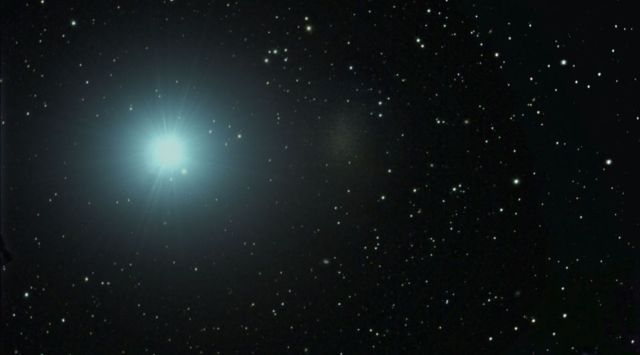Scientists hunt for the second-closest supermassive black hole
Second Closest Black Hole: Scientists proposed a supermassive black hole at the centre of dwarf galaxy Leo I in 2021 but haven't succeeded in capturing imaging data of the behemoth. Now, two astronomers have suggested a method to confirm its existence.
 The dwarf galaxy Leo I appears as a faint patch to the right of the bright star Regulus. (Image credit: Scott Anttila Anttler / CfA Harvard)
The dwarf galaxy Leo I appears as a faint patch to the right of the bright star Regulus. (Image credit: Scott Anttila Anttler / CfA Harvard)In 2021, scientists proposed the existence a supermassive black hole 3 million times the mass of the Sun at the centre of the dwarf galaxy Leo I but it has proven difficult to obtain imaging data. Now, two astronomers have suggested a method to observe this black hole. According to the astronomers, confirming the existence of the black hole labelled Leo I* could make for groundbreaking science.
According to Harvard and Smithsonian Centre for Astrophysics (CfA), Leo I is a dwarf galaxy that is so devoid of gas that it can be described as a “fossil.” The existence of a black hole at its centre was proposed in 2021 when scientists noticed stars picking up speed as they approached the centre of the galaxy. If confirmed, Leo I* would be the closest black hole to Earth after the one at the centre of our galaxy.
Detecting the black hole
Black holes themselves are not visible through imaging techniques but they can be detected based on the environment around them if they are accumulating mass from their surroundings. But since there isn’t much gas in Leo I, this is especially difficult. In their study published in the journal Astrophysical Journal Letters, the astronomers have suggested a new method to verify the existence of the black hole.
“Black holes are very elusive objects, and sometimes they enjoy playing hide-and-seek with us. Rays of light cannot escape their event horizons, but the environment around them can be extremely bright — if enough material falls into their gravitational well. But if a black hole is not accreting mass, instead, it emits no light and becomes impossible to find with our telescopes,” said Fabio Pacucci, lead author of the study, in a press statement.
According to Pacucci, the small amount of mass lost from the stars that wander around the black hole could provide the accretion rate required to observe the massive cosmic object. Red giants, massive old stars in the late stage of their evolution, often have strong winds that carry a fraction of their mass outside the star. The researchers propose that there are enough red giants in the space around Leo I to make the black hole observable.
Importance of detecting the Leo I* supermassive black hole
Avi Loeb, co-author of the study, says that confirming the existence of Leo I* could be groundbreaking. It would be the second-closest supermassive black hole after the one at the centre of our galaxy, with a very similar mass but hosted by a galaxy that is a thousand times less massive than the Milky Way. This fact challenges everything we know about how galaxies and their central supermassive black holes co-evolve. How did such an oversized baby end up being born from a slim parent?” said Loeb in a press statement.
According to NASA, supermassive black holes lie at the centre of virtually all galaxies. Based on prevailing science, scientists expected the centre of Leo I to have a black hole much smaller than what evidence suggests. But Leo I* is a few million times the size of our Sun, similar to the one at the centre of the Milky Way.
This could mean that confirming the existence of Leo I* could potentially change the scientific understanding of black holes. The team behind the suggestion to observe the black hole has obtained telescope time on the Chandra X-ray Observatory and the Very Large Array radio telescope in New Mexico and is currently analysing the new data from the observatories.







